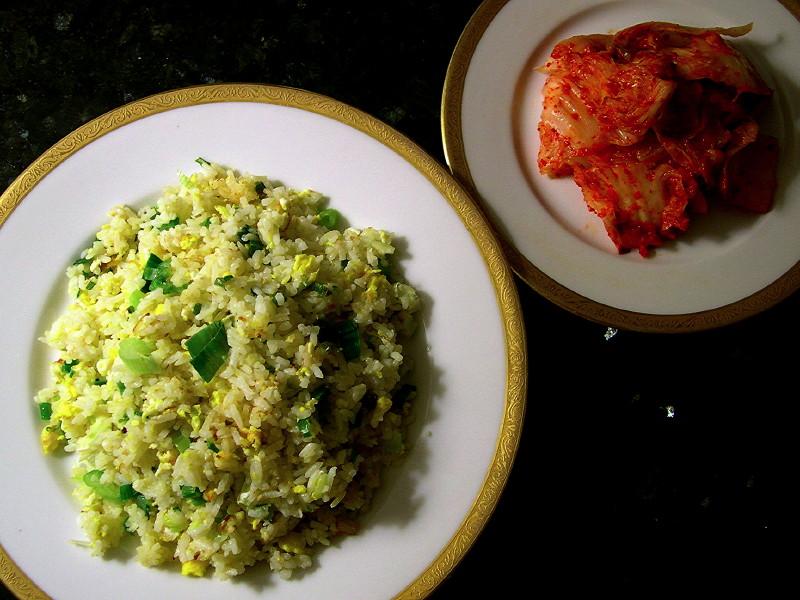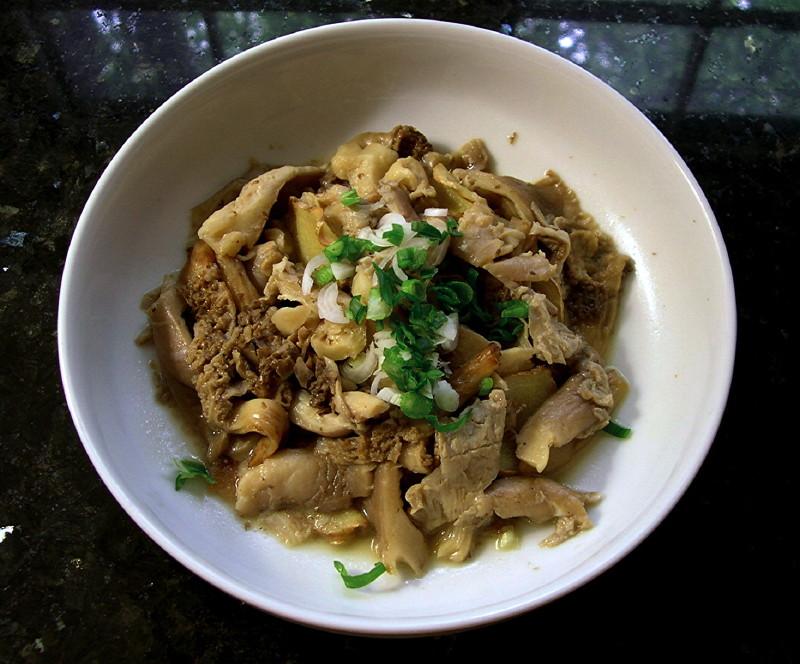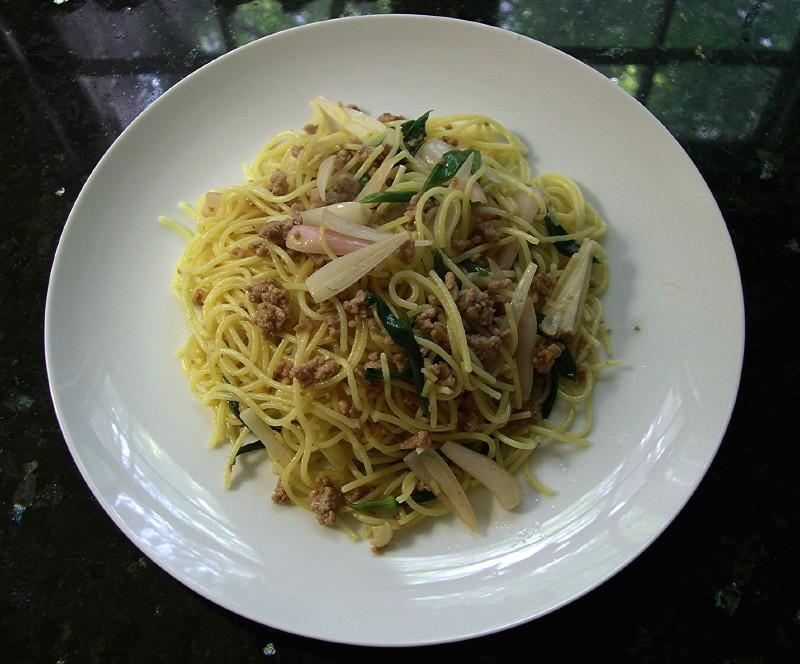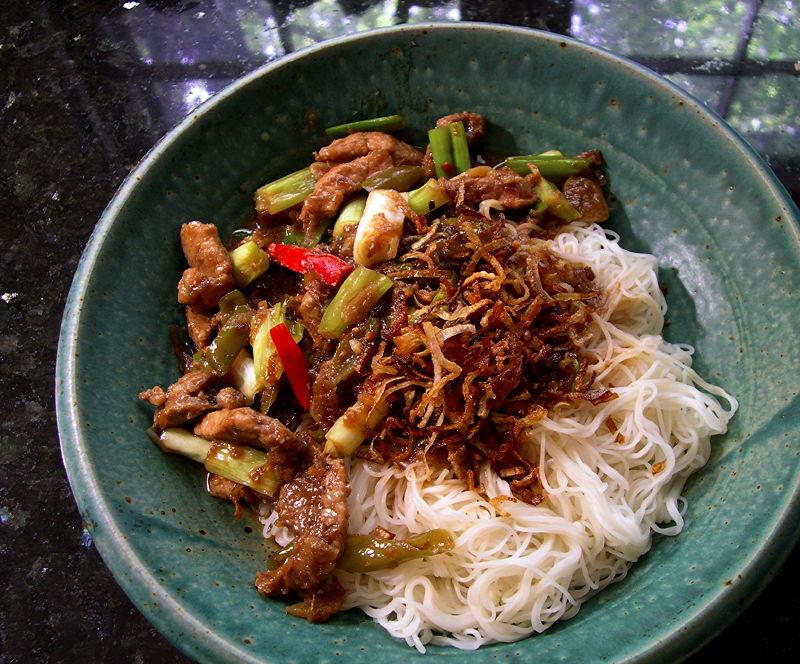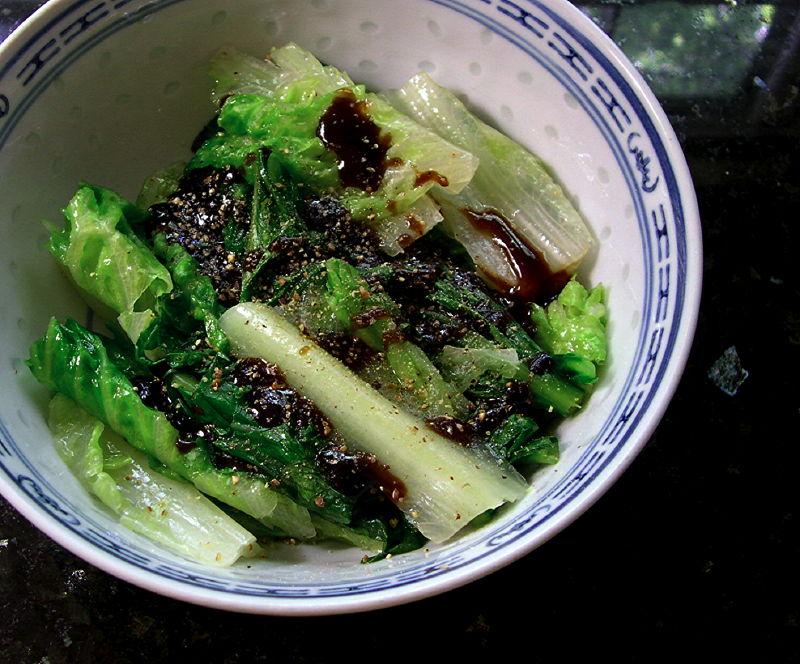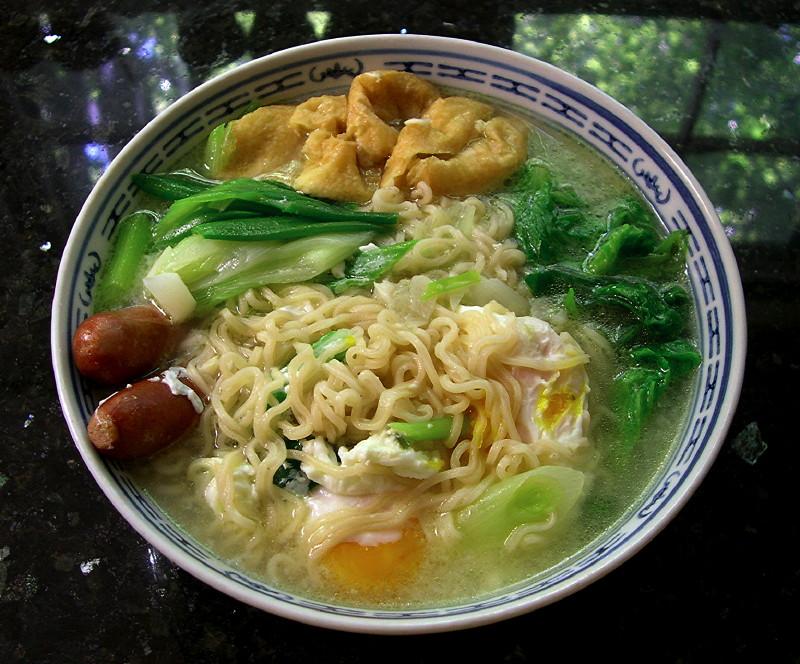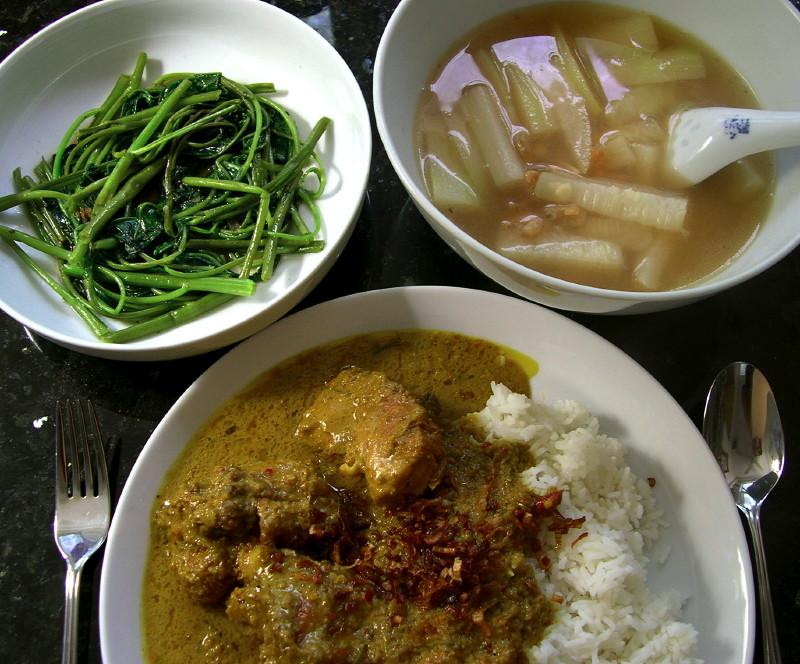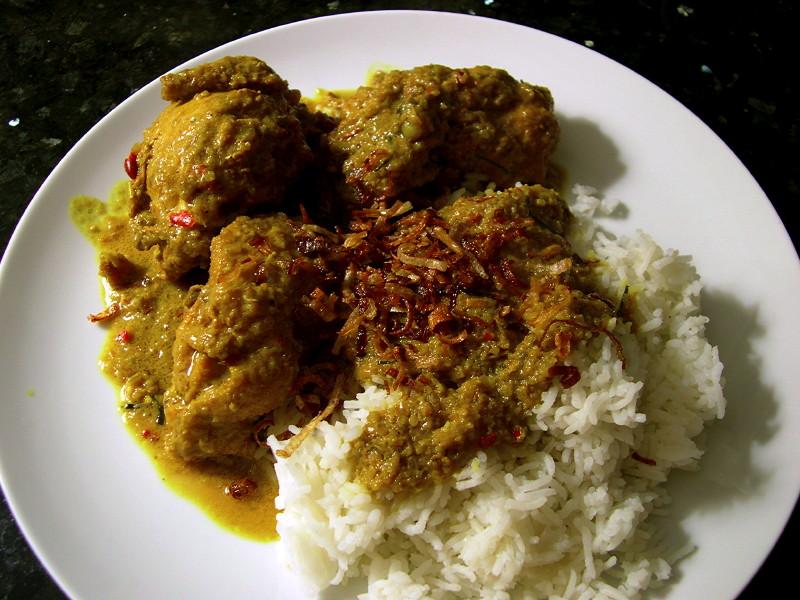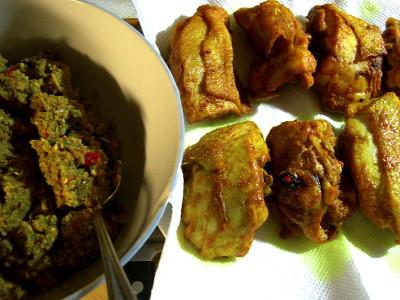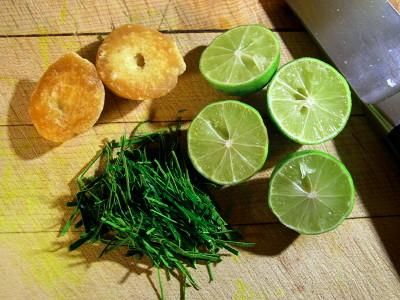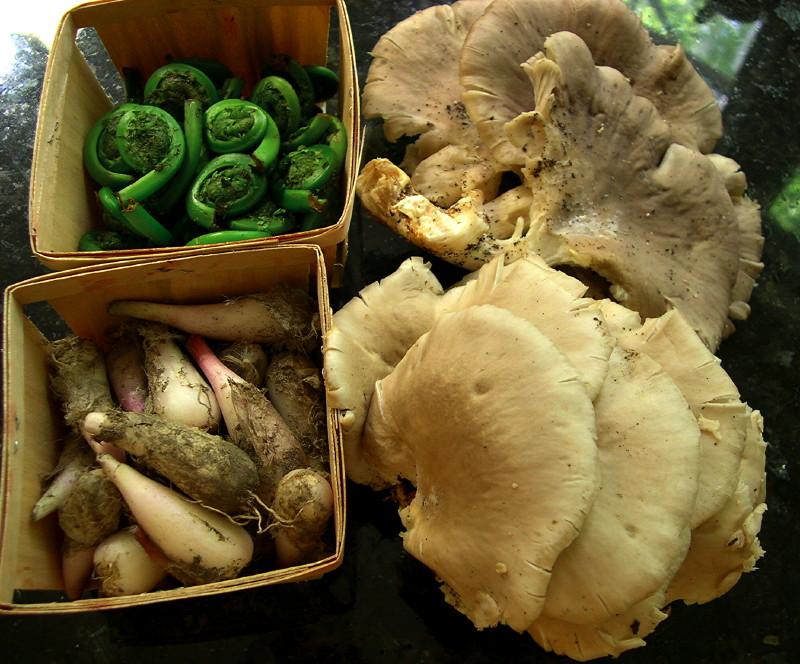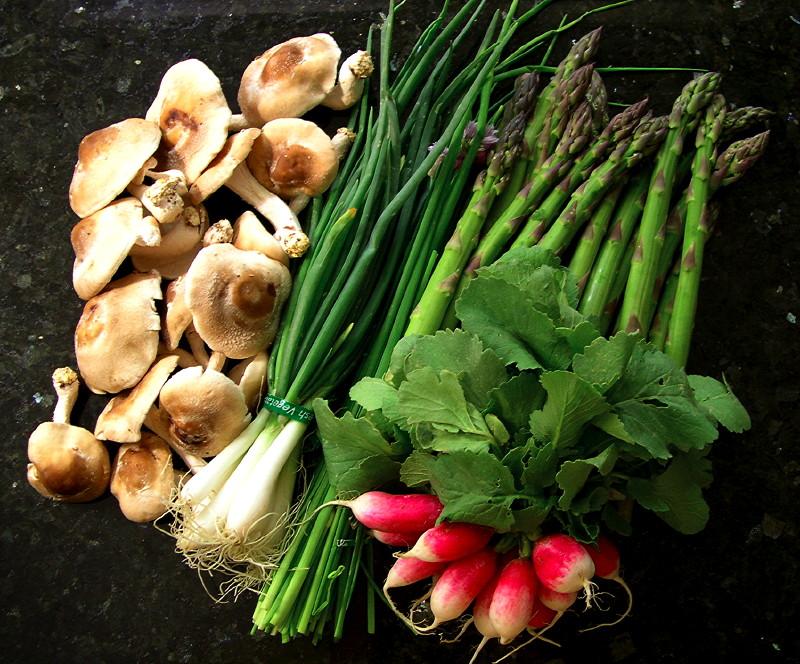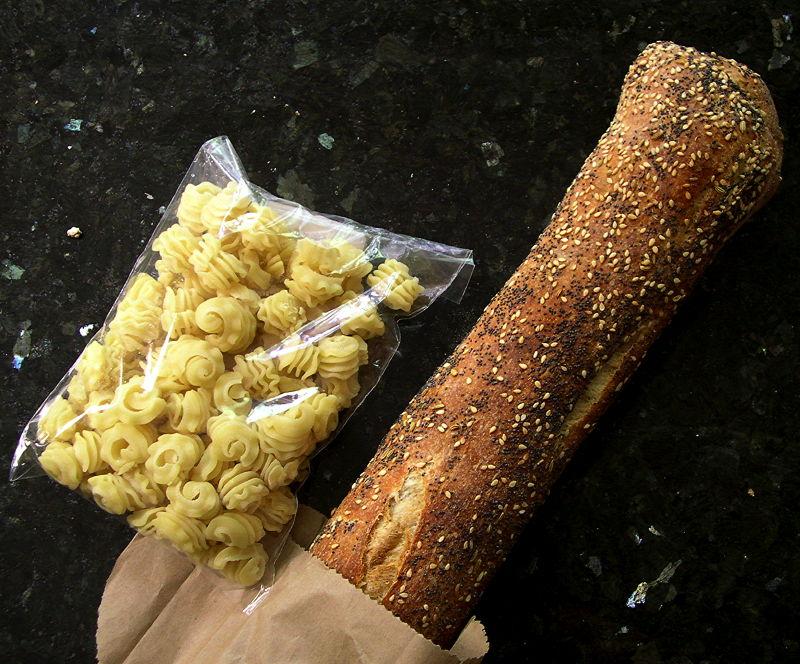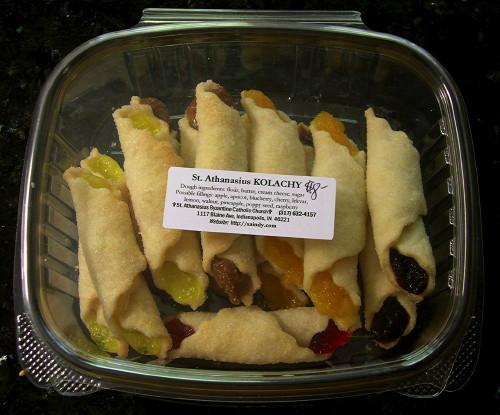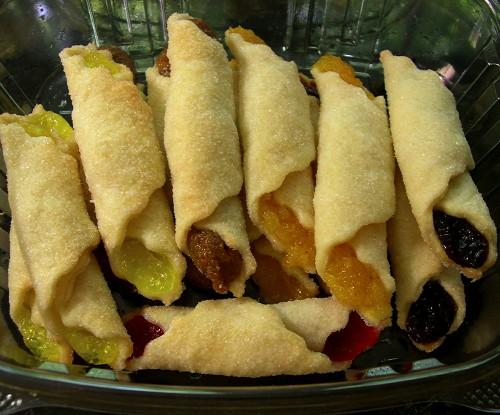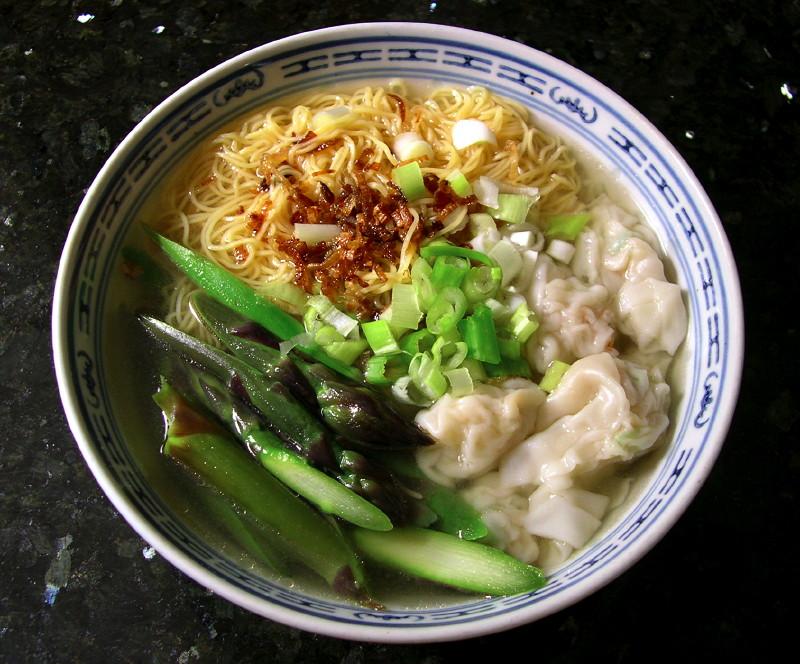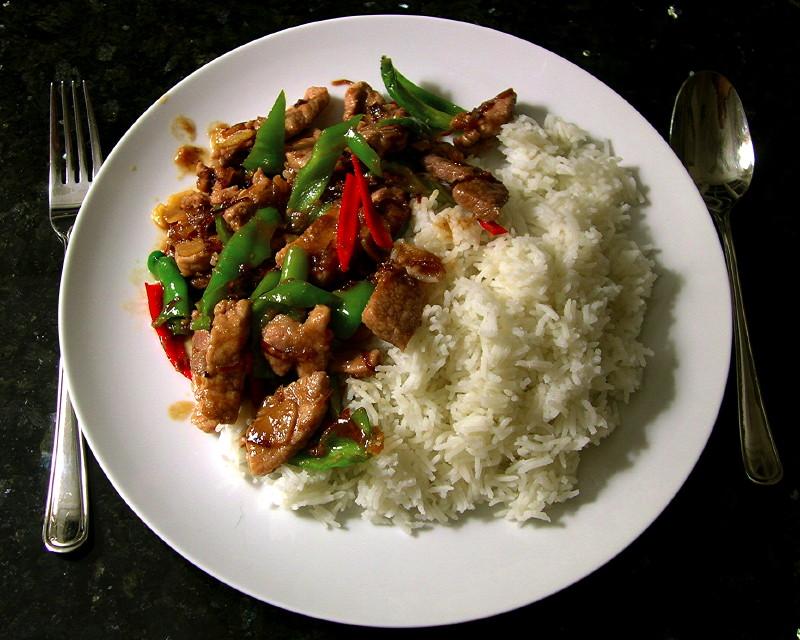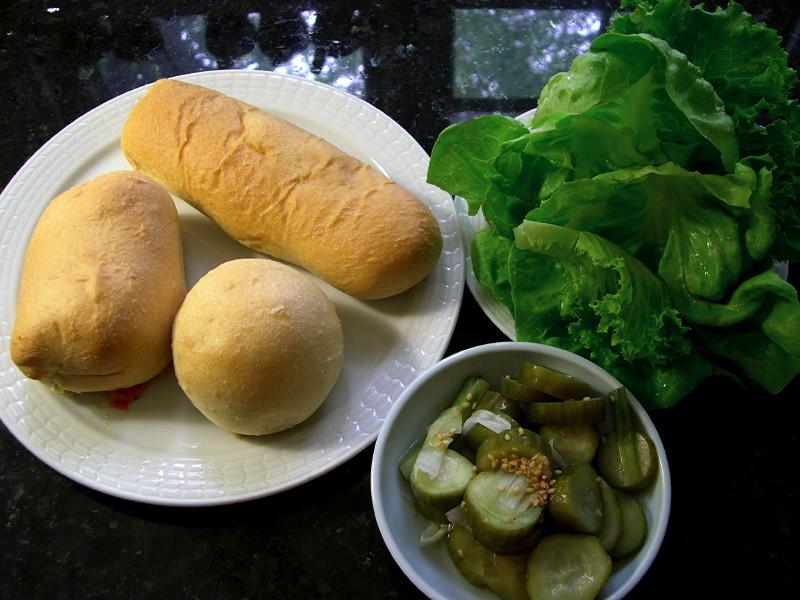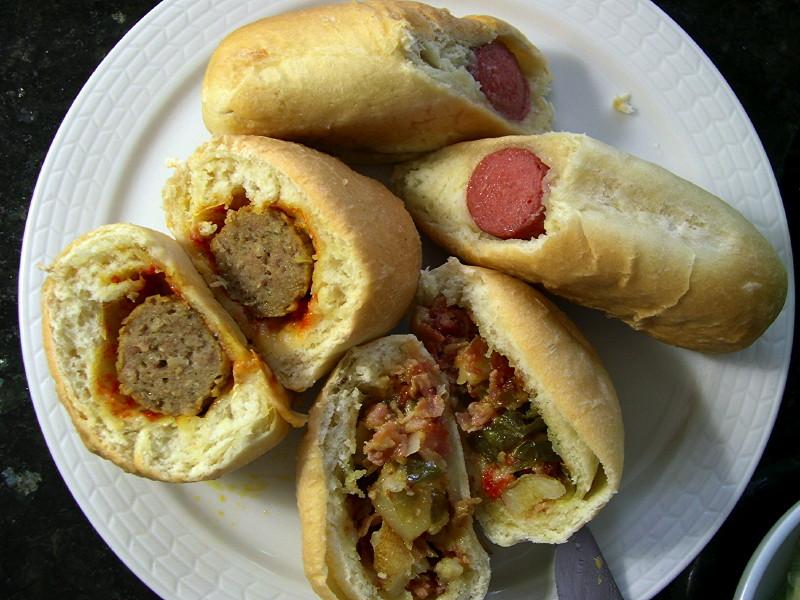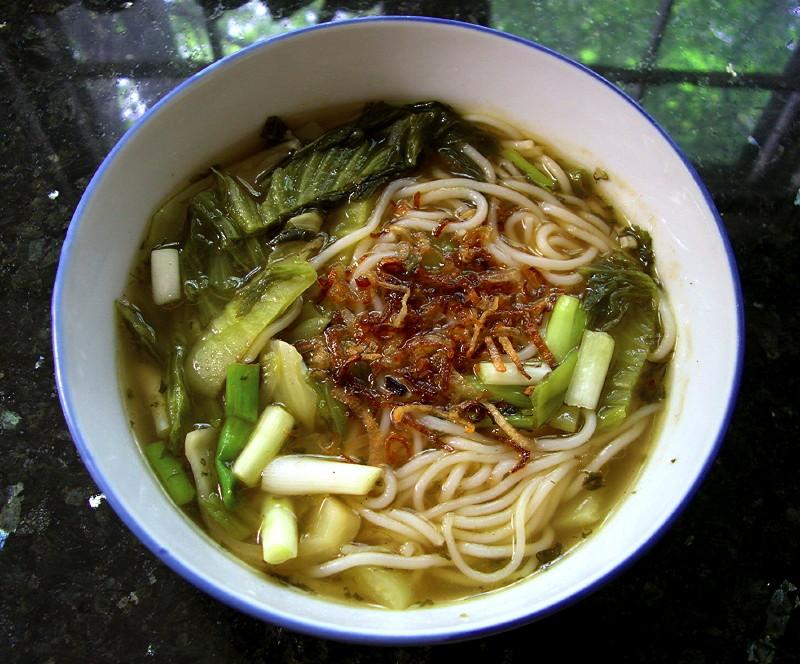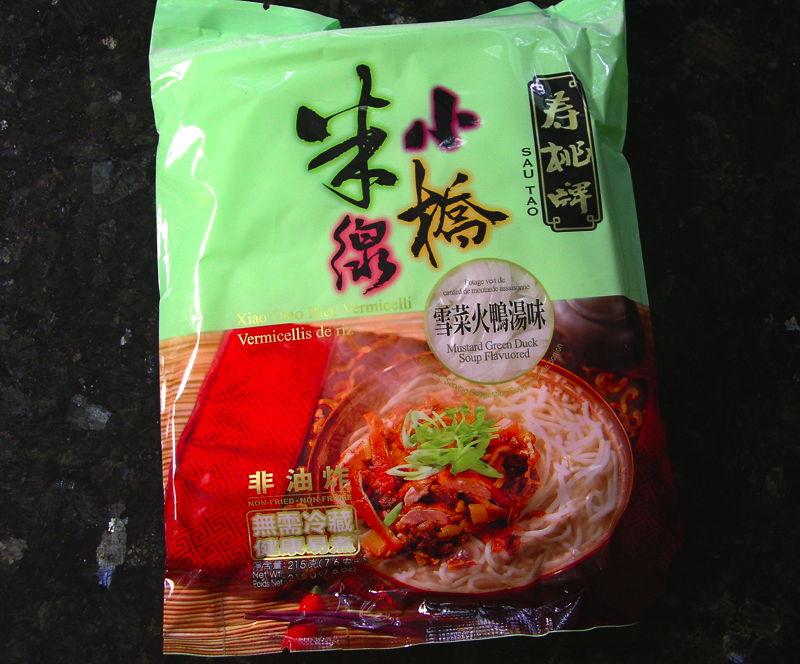-
Posts
3,810 -
Joined
-
Last visited
Content Type
Profiles
Forums
Store
Help Articles
Everything posted by huiray
-
Currently, the oils I have in my refrigerator are: Walnut oil, black truffle oil, black sesame oil, normal sesame oil, toasted sesame oil.
-
A simple late dinner – Duck fat fried rice. Duck fat, chopped-up baby candy onion w/ its greenery, two farm eggs scrambled in situ, 3-day-old rice, some salt. Eaten w/ baechu kimchi.
-
• Fresh oyster mushroom & morel mushroom medley. Sautéed in EVOO w/ some slices of ginger & a bit of salt. • Ramp bulbs (sliced up) & spring onions (green parts mostly) sautéed w/ minced pork. Simply salted. Tossed in the pan w/ capellini fedelini [De Cecco].
-
In all honesty I don't particularly care about what goes into "vegetable oil", so long as it passes the sniff test and the "reading of the label". After all, we are talking about "general purpose stuff", where the taste/characteristics of the oil are not the determining factor in an oil. The amount of garlic, ginger, spices, whatnot that I toss into the hot oil when I make one of my dishes generally would not really affect the final taste of the completed dish - with the exception of olive oil tasting weird in many (if not most) Chinese dishes, as others have also noted. For that matter, DITTO butter in Chinese dishes, and I think this latter one is a really bad combination. When the flavor/whatever of the oil matters, then I certainly use the appropriate oil - special EVOO for delicate salads, for example, which would be sullied by using generic "vegetable oil" or stuff leftover from deep-frying, etc etc. If I am making a "stripped-down" simple dish with just oil, salt and whatever veggie I am frying even "vegetable oil" is suitable FOR ME, so long as it is indeed fairly neutral in taste/smell. And, I am one of those folks who do not smell or detect anything wrong with canola oil for that matter. I look for a decent monounsaturated fat content, low (or zero) trans-fat content, OK polyunsaturated fat content, and credits given for statements about specific grain/whatever oil derivation. I don't have hang-ups about GMO stuff. I really don't care if I live for 6 extra months or a couple of years more because I scrupulously avoided GMO/this-and-that/whatever stuff. YMMV.
-
Some recent lunches. -------------------------- • Left-over stir-fried cincalok pork, over Fuzhou-type wheat noodles (min6 sin3). • Romaine lettuce blanched in oiled hot water, drained, dressed w/ oyster sauce & white pepper. -------------------------- • Sapporo Ichiban chicken flavor instant ramen; with 2 natural casing franks [Dietz & Watson], sliced baby candy onion (with green parts attached), leafy celery, halved fried tofu puffs, and a couple of farm eggs poached in situ. -------------------------- • Leftover Kari Kapitan w/ white rice & deep-fried shallots. • Kangkong stir-fried w/ garlic. • Fuzzy squash (chit kua; ignore the zucchini images!) soup, with sautéed garlic & dried shrimp (har mai) in chicken stock.
-
http://forums.egullet.org/topic/138705-time-to-give-canola-oil-some-love/
-
For general purpose/frying/stir-frying/sautéeing/cooking: 1) Vegetable oil. 2) Corn oil. 3) Canola oil. 4) Olive oil. (frequently California Olive Ranch stuff) 5) Peanut oil. In that order, more or less. Deep frying w/ 1), 2) or 3) depending on which one is currently the one in the gallon jug on the side of the stove.
-
In addition to what Liuzhou stated in his preceding post, I would mention that there are many types of "Asian" eggplants, including Japanese, Chinese, SE Asian and Indian types, all of which do not resemble the large oval-shaped "Italian" type common in the West and in the USA and which is almost always thought of by most folks when one mentions "eggplant" to them. The non-curly elongated type shown by Liuzhou are the most common in Chinese cuisine, but are not the only ones. IMO almost all the other elongated/curly/round-Thai-type eggplants are preferable to those large oval Italian-type eggplants for versatility and taste, even though I am personally not a fan of eggplant in a general sense. Many of these other types are available from Farmers' Markets nowadays, grown by enterprising folks (who are not Chinese) - do you have access to such markets? Pending Liuzhou's reply, I would mention that "sweet and sour pork" is a bona fide dish in Chinese cuisine, especially in Cantonese parts - but the dish indeed differs substantially from the gloopy and sweet and vibrantly orange dish of the same name in American-Chinese cuisine (or, perhaps, even more accurately Chinese Take-Out Cuisine in the USA) which had been "developed" in the belief it satisfied a certain "preference" of USAmericans (and perhaps many Westerners).
-
Kari Kapitan. Based on the recipe in "Nonya Flavours: A complete guide to Penang Straits Chinese Cuisine". Eaten w/ white rice, of course! On the way there (some of the stuff):
-
@mgaretz & ashen, thanks for the info and the links on tri tip!
-
Hmm. When I go to my butcher and ask for PICANHA the nearest equivalent is TOP SIRLOIN CAP. The folks at the butchers also refer to it as TRI-TIP. They are not "surpermarket" butcher folks, they are butcher-butcher folks. It will be cut for me off the top of the slab of sirloin that they haul from the cold room, and will have the heavy thick layer of fat on the top that is characteristic of the cut, which is not commonly used/asked for in Anglo-Saxon cookery, and have the triangular shape that appears to give rise to the name. Unless the cutter is very familiar with the cut, I will also sometimes have to stop them from cutting off the top fat layer, specifying that only the slightest trimming should be done. It is possible that a similar-looking cut will have been denuded of all that fat cap layer in the US in some places, in pursuit of the (mistaken) belief that any such fat is bad, bad, bad for you.
-
Broad Ripple Farmers’ Market (BRFM): Anna Belle’s Garden: Fresh oyster mushrooms, ramp bulbs, fiddleheads. Amelia’s Bakery: Poppyseed, aniseed & sesame seed Francese loaf. The Apple Works: English thyme. Harvestland Farm: Western chives. Nicole-Taylor’s Pasta: Bag of fresh radiatore. Silverthorn Farm: French Breakfast radishes, green onions. Binford Farmers’ Market: Shamrock Farm: Fresh shiitake mushrooms. St. Athanasius Bakery: Kolachy (with the traditional fruit-based fillings, assorted). Unknown vendor: Asparagus. Asia Mart: Fuzzy squash, long hot green peppers, Japanese cucumbers, yu choy sum, J.Z. bamboo shoots, red-flushed yin choy (edible amaranth), lettuce stems (celtuce), kangkong (water spinach), lemon grass, wong nga pak (Napa cabbage), Thai basil, shimeji (brown beech) mushrooms, fresh galangal, black Chinese jujubes (dried), fresh skinny wonton noodles, dried anchovies (small ones, “stock fish”), firm tofu, fried tofu puffs, chicken drumsticks.
-
Yes, the tassels are the suspension points - one holds one of them in one hand with the fingertips while doing the weighing procedure. The choice of tassel depends on whether one is to use the x1 or the x10 "scale", the one nearer the pan for the x10 and the one further from the pan for the x1 scale. Some of these also came with an alternate counter-weight for the corresponding "scale". They were crafted and calibrated against the accepted standards, such as they were, in those olden times; and were therefore not exactly el-cheapo throw-away things. Nevertheless, accuracy and reproducibility were doubtless not quite what modern standards would demand.
-
Yes, they are still the "standard" weighing instrument in many old-style Chinese medicine shops/apothecaries both in the West and in the East. The larger ones (weighing in taels and catties) were still routinely used in other markets and stores when I llved in SE Asia and are still used in "traditional old-style" shops where they still exist, AFAIK. My mother used such a scale for many weighing applications and I have many memories of watching merchants weigh out stuff all over the place using such instruments. I've done it myself in my youth using these instruments, and it isn't hard at all to do so long as you are in a "stable" environment, no stiff breezes, no one banging around next to you. Some of the very small ones in Chinese medicine shops were made of precious and semi-precious materials (ivory and gold, for example) and were kept in velvet/damask/etc padded-and-lined boxes. They were quite valuable in their own right, and seemed to be remarkably accurate for what they were (but cannot prove it, of course), and I remember watching a family friend, a Chinese apothecary, weigh out tiny amounts of herbs with his micro-scale while wearing gloves. ETA: Of course, proper calibration would have been an issue, as I alluded to in the post that follows.
-
Regarding a hanging scale for small quantities... http://www.chinesesinseh.com/toolsoftrade/Liteng/litenginfo.htm :-) (and some info on units...) Of course, the NIST in the US might not entirely approve of this instrument.
-
-
Shooting has begun. http://www.bostonglobe.com/lifestyle/names/2014/05/18/top-chef-begins-filming-boston/2lBgrQZQh1XVHZrkL3cZRJ/story.html
-
Here's the pricing (exclusive of shipping) if you buy Red Boat directly from the producer. My local Chinese grocery has the 40ºN 500mL bottles available - I don't remember exactly what they are charging but I think something in the 7-9 buck region seems about right if I remember correctly. (I'm sure they get "wholesale/retail" pricing FWIW too) My most recent purchases (i have done it several times) were from the Red Boat online website for these 500 mL bottles, plural. Yes, my personal consumption of fish sauce, although not excessive, would certainly be more than a single bottle lasting a lifetime. :-)
-
Goatjunky, on 02 Apr 2014 - 11:59 AM, said: Yes, how did it go? BTW, I was talking (emailing, really) to a past work colleague of mine, who used to be with Kodak in Syracuse (not that far from the Finger Lakes region ;-) ) many many years ago and he instantly recognized "beef on weck" and reminisced about those Weck Rolls, which he cannot get where he is now, of course, in the Pacific NW (nor when he was working in the same company as I did in central IN)...and about the particular combination of that GENEROUS amount of mustard and the sliced beef and the rolls...
-
Willie, you're welcome and thanks for the compliments. I actually have several brands in my fridge/pantry/kitchen including Flying Lion, Three Crabs, and that Red Boat brand; besides other fish sauces such as nuoc mam pha san and mam ca com an lien. To me, Red Boat does have a cleaner taste and goes down smoothly if one were to sip it directly :-) and, as TheCulinaryLibrary noted, it is not lost on me that it is one of the brands that use just anchovies, salt and water. It also is stated to have a higher protein content, FWIW. (I use the 40ºN one) Since I don't use *that much* fish sauce, I tend to go with Red Boat in recent times (after I first tried it out) but it is also true that when cooking complex dishes with lots of other aromatics and spices going in it doesn't matter that much. In fact, I can't remember if I used Red Boat or Flying Lion the last time I made a pot of pho stock, where much more than just a few splashes of fish sauce go in. When just a few splashes of fish sauce are called for, in a stir-fry dish for example, or when mixing up a saucer of a dipping sauce with fish sauce in it straight from the bottle I just go with the Red Boat nowadays.
-
Heh Ya Kay. (Stir-fried Cincalok Pork) I based this dish on the recipe in "Nonya Flavours: A complete guide to Penang Straits Chinese Cuisine". Stuff that went in: Sliced shallots, fried, reserved; sliced garlic, fried, half reserved; cincalok; sliced pork (with adequate marbling); slurried tamarind pulp (w/ the pulp from 1 sweet tamarind pod + 1 sour tamarind pod), mirin-fuu (instead of plain sugar); diagonally-sliced de-seeded hot long green chillies + red Thai chillies almost at the end; then the reserved fried shallot and garlic slices. Eaten w/ white rice.
-
Is it that important that you get an EXACT weight of something like 1.3 grams of whatever you are weighing out? What recipes are you following that specify "this much exactly, no more, no less" to one decimal place? Does it matter if you get a bit more than what is strictly called for in such a recipe (if it exists) such that you can use it another time, in which case one might get somewhat more than the recipe amount when shopping...I would, anyway. Surely it cannot be that important that one knows EXACTLY how much of a herb or spice one has taken from a bulk bin, down to the 1st decimal place... On a related note, the warnings about a small digital scale being found on one's person by a cop- is not to be trivialized. I might also mention that this is botanically a herb, while this is "spice"; if one is intending to plead that one is using such a scale for measuring out small quantities of herbs and spices.
-
Aren't you going to do a bar crawl along Bourbon Street** and roam around the Quarter and Rue Royale? (Galatoire's too, of course - maybe earlier in the day. :-) ) Remember you can lurch from bar to bar along the street with open drinks in hand :-) and maybe catch a few hours of sleep at daybreak before you change into your wedding duds. **p.s. There is actually quite a bit more around the FQ in terms of history than just alcohol availability and adult entertainment and food. ;-)
-
Late-ish lunch. Kolaches, from this place. Polish Hot, Kolache Fiesta, Meatball. Eaten w/ some lettuce & some pickled cucumbers.
-
Brunch. "Mustard Green Duck Soup Flavored" fat ("fresh", in a sealed inner pouch) rice noodles; with sauce, seasoning & seasoned vegetable sachets inside as well. Augmented w/ half of a head of harm choy (pickled mustard - of similar type to what is in the sachet that comes w/ the package), chopped up, simmered in water w/ the seasoning sachet contents, plus some rice vinegar, plus mirin, plus a couple dashes of Maggi sauce. Plus trimmed scallions and dressed w/ deep-fried shallots when served. :-) The package of stuff I used and built on:



